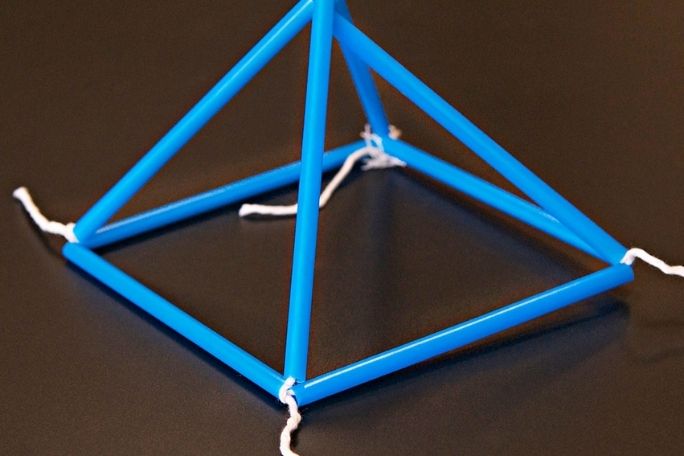Lesson summary
This is a STEAM lesson, which adds the Arts to STEM (Science, Technology, Engineering and Mathematics). To find out more about STEAM and STEM, click here.
In this lesson, students connect mathematical knowledge with Visual Arts by creating models of three-dimensional shapes using straws and string (geometric mobiles). The lesson explores features of three-dimensional shapes, including faces, edges, corners (vertices) and surfaces. It further extends into an exploration of the two-dimensional shapes that form each face, engaging students in an exploration of how the area of a two-dimensional shape can be approximated using formal units. In development and analysis of these designs, students will explore and discuss the art element of line, reflecting on its prominence in their design and the types of lines that are present.
Learning intentions:
Students will...
- understand the key features of three-dimensional shapes
- calculate the approximate area of a two-dimensional shape using formal units
- understand art elements and principles.
Success criteria:
Students can...
- explain what a three-dimensional shape is in their own words
- identify faces, surfaces, edges and vertices (corners) of a three-dimensional shape
- explain what area is
- use square centimetres to find an approximate measure of area
- identify the types of lines in their model
- discuss strategies to create balance in their mobiles.
Lesson guides and printables
Lesson details
Curriculum mapping
We encourage you to teach STEAM both through and between disciplines (transdisciplinary).
This lesson could be used across multiple strands of the curriculum, including Science, Maths, and Visual Arts. Consider focusing on a curriculum strand that will complement other areas of learning you and your students are working on.
Syllabus outcomes: MA2‑1WM, MA2‑2WM, MA2‑3WM, MA2‑5NA, MA2‑7NA, MA2-10MG, MA2-14MG, VAS2.1, VAS2.2, ST2-5WT.
General capabilities: Critical and creative thinking, Literacy, Numeracy
Unit of work: Learning Through Art & Craft – Primary.
Time required: 120 mins.
Level of teacher scaffolding: Medium – the level of support required will depend on a number of factors, including student comfort with construction and the complexity of the shapes that students decide to create.
Resources required
- 3D Shapes Venn Diagram Sheet (one per student)
- 3D Shapes Design Sheet
- 3D Shape Analysis Sheet (printed back to back, one per student).
- 10mm grid paper
- Black Straws
- Device capable of displaying presentation and video
- Making a 3D Model Step-by-Step Instructions (equipment to project to the class).
- Pencils and erasers
- Student Worksheet (one copy per student)
- Scissors (ensure left- and right-handed scissors available)
- Spaghetti string (colours at teacher’s discretion)
Skills
This lesson is designed to build students’ competencies in the following skills:
- Creativity
- Critical thinking
- Problem solving
Additional info
STEAM Education:
Over recent years, the importance of STEM has been heavily promoted and discussed within fields of education. This has been within the context of ensuring that the next generation of students are provided with relevant knowledge and skills for the 21st century. STEM acknowledges the importance of the interrelated nature of science, technology, engineering and mathematics and the prominence of these skills in a world of continuous technological advancement.
What was missing from this original acronym, however, was an acknowledgement of the vital importance of artistic and creative thinking. The ability to think outside the box to develop artistic and creative solutions.
The relevance of art is integral to success in all of the original STEM areas, and so STEAM education is now moving to the forefront. Significant figures in science and technological advancement (notably Leonardo DaVinci, Albert Einstein and Steve Jobs) valued and applied the contribution of artistic skill into their work and art, design and creativity is also pivotal to success in industries such as marketing, advertising and promotion.
This is an original Cool+ lesson.


Welcome back!
Don't have an account yet?
Log in with:
Create your free Cool.org account.
Many of our resources are free, with an option to upgrade to Cool+ for premium content.
Already have an account?
Sign up with:
By signing up you accept Cool.org's Terms and Conditions(Opens in new tab) and Privacy Policy(Opens in new tab).